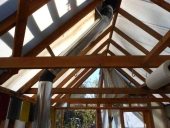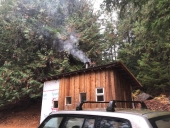
















Kevin Riley wrote:Having just built a great stove out of firebrick, I'm not in a huge hurry, but I'm thinking my next stove will also be cast core. I found your post, Troy, after I watched this video:
https://www.youtube.com/watch?v=7ANMXGrxgnE
I'm hoping to ride on the coattails of your question, soaking up suggestions. The criteria I'm filtering ideas with, are as follows:
1) Very Durable, especially in feed tube area
2) Insulative (keep the heat concentrated in the burn tunnel for optimal combustion)
3) The more eco-conscious and locally available the materials, the better
4) Cost effective
If it doesn't meat those criteria, I would be tempted to stick with firebrick.




Kevin Riley wrote:Having just built a great stove out of firebrick, I'm not in a huge hurry, but I'm thinking my next stove will also be cast core. I found your post, Troy, after I watched this video:
https://www.youtube.com/watch?v=7ANMXGrxgnE
I'm hoping to ride on the coattails of your question, soaking up suggestions. The criteria I'm filtering ideas with, are as follows:
1) Very Durable, especially in feed tube area
2) Insulative (keep the heat concentrated in the burn tunnel for optimal combustion)
3) The more eco-conscious and locally available the materials, the better
4) Cost effective
If it doesn't meat those criteria, I would be tempted to stick with firebrick.








Troy Fairclough wrote:
this is the mixture i am using
http://www.backyardmetalcasting.com/refractories.html
very similiar to the one posted in your video which i have also watched, but i think it will be harder and more durable.




Matt Walker wrote:
Troy Fairclough wrote:
this is the mixture i am using
http://www.backyardmetalcasting.com/refractories.html
very similiar to the one posted in your video which i have also watched, but i think it will be harder and more durable.
Hi guys, that's my cast core video you linked to. Just a quick note, I've tried the backyard metal casting mix exactly as written there. It turns to powder after not very long as the heat breaks the bond in the portland. I'd strongly recommend leaving Portland out of any of the real hot areas.








K.




Kevin Prata wrote:Hi Matt -
What ratio of furnace cement are you using? Just curious. I was (am) planning on a vermiculite + refractory mix at a 4:1 ratio.
Regards
K.




Matt Walker wrote:Troy, I describe my mix in the video linked above. Furnace cement as an additive is all you'll need.









Matt Walker wrote:
mass in the burn area actually cools the gasses as the heat is drawn in to heat the high mass of the bricks. In this way any mass in the riser will actually rob heat from the burn for a while to achieve that hot effect you are describing,




Just to clarify, your riser design is simply ONE homogenous material enclosed by the 17 gallon drum to hold it together, is this correct? Then you simply place your external heat barrel over that assembly to complete the stove, correct?
I thought the CORE of the riser was ideally firebrick (dense material that absorbs/radiates heat ), then wrapped by an insulating layer which in turn is contained by metal shell, so that in essence the entire riser is insulated from the external barrel chamber, but that the CORE of the riser itself did not refract heat, but rather GOT HOT, to enhance chimney effect, and burn gasses?
I thought the purpose of YOUR riser design was simply to split the difference between insulative and heat absorbing, so that the riser would not need to be constructed of multiple sandwiched layers, thus making the design and build simpler.




Matt Walker wrote: Here's an old heater I built that was poorly insulated and worked just great. And, it's in an old metal tub, just like you are discussing.
http://www.permsteading.com/viewtopic.php?f=6&t=8




What did you make the heat riser from? and what was the diameter of the riser, burn tunnel, and exhaust?
If those cracks were left exposed and not covered with cob, would that present a carbon monoxide hazard? or would the cracks in the burn core suck air rather than emit it?








jacob green wrote:
Someone really needs to figure out how to burn 6-8 foot fuel in the feed tubes to reduce the amount of refills during the day. I present several ideas in that thread. Maybe you will think of something to add.
thanks again.




positively optimistic 🙂 https://www.youtube.com/@613Builds








Rocket Mag evolution timeline: http://www.permies.com/t/52316/rocket-stoves/Rocket-stove-heats-water-pics
Rocket Mag Thread: http://www.permies.com/t/54074/rocket-stoves/Rocket-Mag-heater-Rocket-Mag




... it´s about time to get a signature ...










positively optimistic 🙂 https://www.youtube.com/@613Builds




Troy Fairclough wrote:pictures of the 8" core mold i made today, complete with measurements from the 15 dollar book by ianto evans.
positively optimistic 🙂 https://www.youtube.com/@613Builds









positively optimistic 🙂 https://www.youtube.com/@613Builds

















Matt Walker wrote:
Just to clarify, your riser design is simply ONE homogenous material enclosed by the 17 gallon drum to hold it together, is this correct? Then you simply place your external heat barrel over that assembly to complete the stove, correct?
Yes.
I thought the CORE of the riser was ideally firebrick (dense material that absorbs/radiates heat ), then wrapped by an insulating layer which in turn is contained by metal shell, so that in essence the entire riser is insulated from the external barrel chamber, but that the CORE of the riser itself did not refract heat, but rather GOT HOT, to enhance chimney effect, and burn gasses?
No, in my opinion this is less than ideal, although it still makes a good heater. I describe why above, but basically anything in the burn area that gets hot cools the gasses, not the other way around.
I thought the purpose of YOUR riser design was simply to split the difference between insulative and heat absorbing, so that the riser would not need to be constructed of multiple sandwiched layers, thus making the design and build simpler.
No, the purpose of my riser is an attempt to improve performance over a firebrick riser. I think a firebrick/insulation riser is a simpler build/design.
All that said, you can build a dang good heater with heavy stuff, and people do all the time. Here's an old heater I built that was poorly insulated and worked just great. And, it's in an old metal tub, just like you are discussing.
http://www.permsteading.com/viewtopic.php?f=6&t=8

positively optimistic 🙂 https://www.youtube.com/@613Builds






|
Sometimes you feel like a nut. Sometimes you feel like a tiny ad.
Play Your Way to a Sustainable Lifestyle: Uncover Permaculture Principles with Each Card
https://gardener-gift.com/
|




